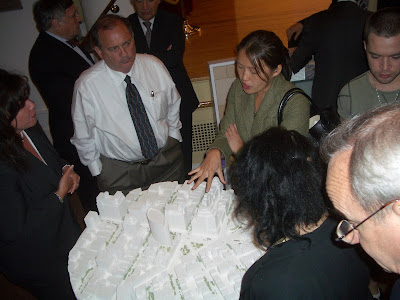
• I’m Michael White offering this comment in the name of Noticing New York,- an independent entity dedicated to the proposition that developing New York and appreciating New York go hand in hand.
• As real estate attorney and urban planner, I am thankful to be able to offer this testimony in opposition with the benefit of having reflected upon excellent prior testimony.
• The current revised plans involve punching down from the north and shrinking the boundaries of the Greenwich Village Historic District with two piercing stabs whose significant increases in density will have considerable value to the property owners.
• In one case, a developer hopes to inherit, undiminished, an ability to build at greater density.
• And, St Vincent’s proposes to benefit by using its special status in an ad seriatim manner to achieve an increase in density for the other site as well. Its financial gain will be more pronounced because protection for the O’Toole Building in place when it bought the site would be set aside.
• Each of these two proposed spearheads of density represent subsidies to the extent that they would NOT be given in accordance with generally recognized principles. St. Vincent’s President and CEO Henry Amoroso (on the “Stoler Report”) said that St. Vincent’s was looking to “leverage” its real estate assets. What is proposed here is not “leverage.” Instead, St. Vincent’s special status is to be used to transmute the value of its real estate rights, not only for itself but for real estate developers purchasing from them. Creating real estate value (at community expense) so that it can be sold to a developer is the most obvious subsidy imaginable.
• This is not a hardship application- This is a subsidy application!
• Should subsidy be furnished by bending the community’s landmarks laws? If so, there are a lot of venerable nonprofit institutions in Greenwich Village that can be subsidized by the creative carving up and selling of the district. In the end we will have no Greenwich Village and no historic district left. We will also have no operational principles with which to protect other districts.
• I suggest that the Commission be on guard against getting involved in the hospital subsidization business. It is a frightening morass except to experienced insiders. Regulations and highly complex reimbursement formulae force hospitals to dance operating with the thinnest margins in the country.
• Subsidies if not properly designed can turn out to provide odd inducements. For instance, a subsidy that operates by rewarding a hospital to move and use its special status to create density and wipe out historic district protections will likely result in hospitals moving repeatedly and too often, as each move will generate a payday. Coleman and Link buildings were built in 1984 and 1987: Why are they being decommissioned now? The way to avoid the question is to avoid the artificial creation of a subsidy.
• The current revised proposals are clearly better than the original proposals the Commission rejected but anyone who thinks that relative benchmarks can be set by the seriously flawed proposals that preceded these revisions is in error.
• The proposals are commendable efforts if the goal is to shrink the Greenwich Village Historic District, but they are not acceptable if the goal is to protect the district.

No comments:
Post a Comment